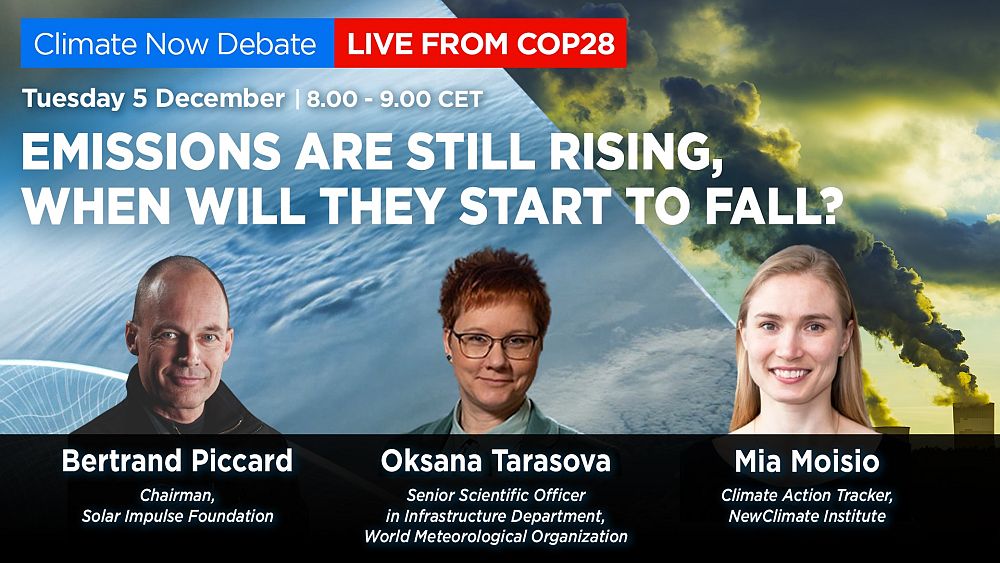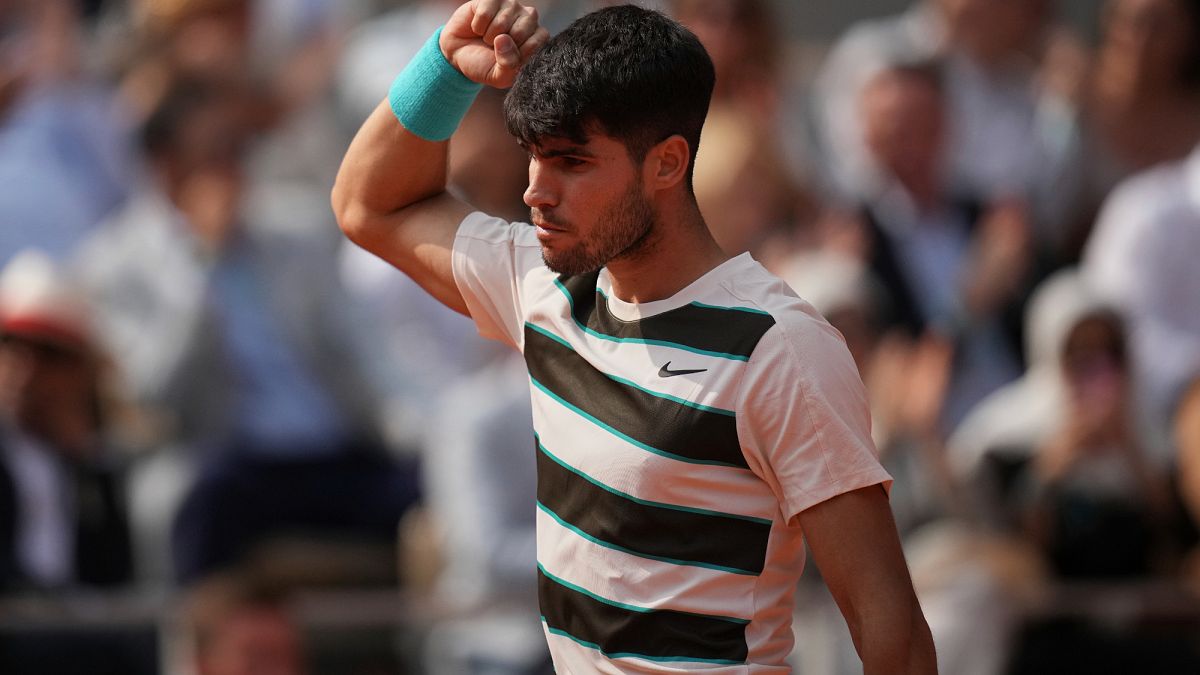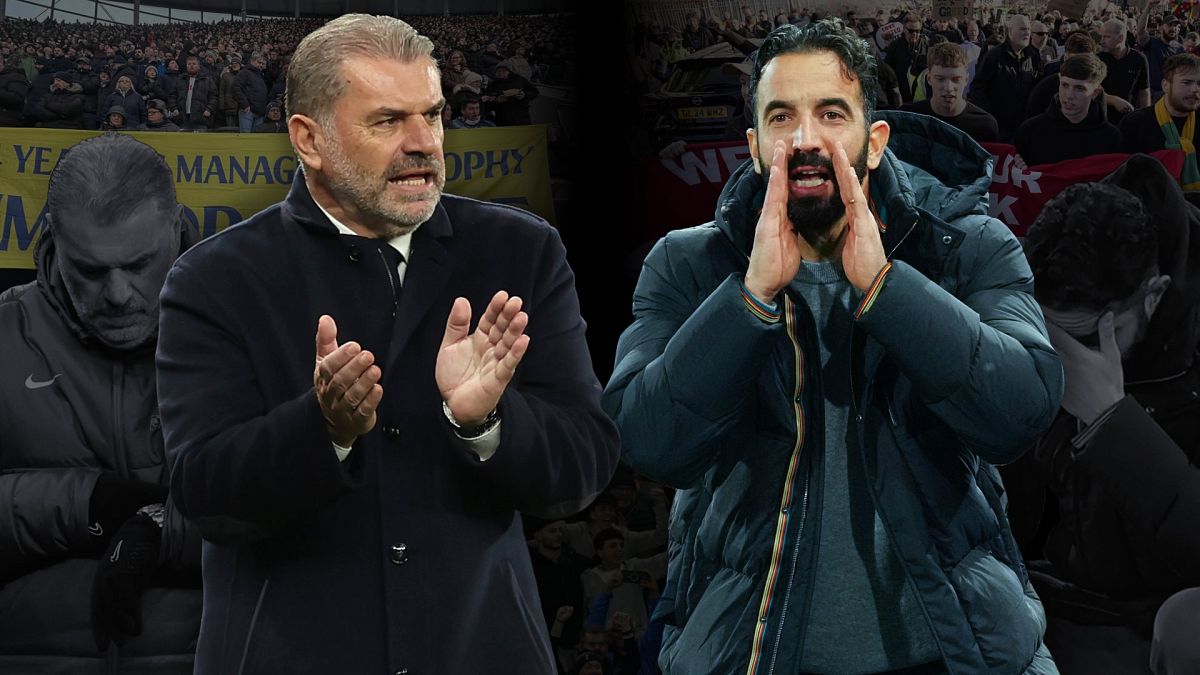Emissions are still rising, when will they start to fall?

For our latest Climate Now Debate, broadcast live from COP28, we’ll be discussing whether an emissions peak is in sight for greenhouse gases.
Despite repeated warnings from climate scientists, greenhouse gas emissions (GHGs) are still rising, with CO2 concentrations reaching a record high in 2023 of nearly 420 parts per million in our atmosphere. This comes as many expect last month to yet again set a new high as the warmest November on record, following a year of recording breaking figures from the Copernicus Climate Change Service.
From wildfires in Europe to floods in Pakistan, the reverberations of our failure to reduce emissions are being felt on a global scale. The IPCC says emissions must peak before 2025 if we are to meet the targets of the Paris Agreement, but time is rapidly running out.
Our expert panel of climate scientists and policymakers will be debating why GHGs are still rising live from COP28 in Dubai on December 5 at 8am CET (11am UAE Time).
You can watch the debate in this article or on Euronews’ YouTube Channel.
While there has been some progress, drastic cuts still need to take place if warming is to be limited. In fact, the UN Environment Programme (UNEP) states in its Emissions Gap 2023 Report, that projected emissions need to fall by a further 28 per cent by 2030 to stay within the Paris Agreement 2°C pathway. To have any hope of meeting the 1.5°C pathway target, they need to fall by a huge 42 per cent.
With GHGs rising by 1.2 per cent between 2021 and 2022, and with emissions reaching a record high of 57.4 Gigatonnes of Carbon Dioxide Equivalent (GtCO2e) in the same year, according to the UNEP, is there any hope of emissions peaking in time?
Our Climate Now live event also ties in with the release of the latest Climate Action Tracker report, the latest World Meteorological Organisation greenhouse gas bulletin report and the latest updates from the Copernicus Climate Change Service, which we will be discussing with our guests.
The Climate Action Tracker (CAT) report released on December 5 is one of the most highly-regarded and hotly-awaited scorecards on progress to reduce emissions, and the outlook is not good.
It finds that “progress made in closing the global gap in climate action remains woefully inadequate — 41 of 42 indicators assessed are not on track to achieve their 2030 targets.”
The scientists expressed their frustration at a lack of progress. “We need to phase out fossil fuels completely, without a back door,” said Prof Dr Niklas Höhne, from the NewClimate Institute. He said there was too much reliance on carbon removals, a technology that is considered expensive and unproven at scale.
A collaboration between Climate Analytics and NewClimate Institute, the CAT has been providing independent analysis to policymakers since 2009.
Our panellists are:
Bertrand Piccard, Chairman, Solar Impulse Foundation
Both psychiatrist and explorer, Bertrand Piccard made history by achieving two aeronautical firsts: a non-stop round-the-world balloon flight and a solar-powered round-the-world flight. A pioneer in considering ecology from the angle of economic profitability, he has been promoting renewable energies and clean technologies since the early 2000s. With the Solar Impulse Foundation, which he chairs, he is demonstrating that it is possible to meet ecological challenges without undermining economic development. In April 2021, he achieved his first goal of identifying and labelling 1000 “Efficient Solutions”.
A humanist, this former United Nations ambassador for the environment, puts his reputation at the service of progress, sustainability and quality of life, three themes reflected in his concept of “qualitative economy”. To support his approach, he strives to bring together the forces at work, raise public awareness and encourage political action through advocacy for modernization of the legislative framework and guides to accelerate the adoption of clean technologies and accompany political and industrial decision-makers in their ecological transition.
Oksana Tarasova, Senior Scientific Officer in Infrastructure Department,World Meteorological Organization
Dr Oksana Tarasova is in the World Meteorological Orgainzation since 2009. She is a Senior Scientific Officer in the Infrastructure Department since August 2022 working on the development of the Global Greenhouse Gas Monitoring Infrastructure, she was a Head of the Atmospheric Environment Research Division in Science and Innovation Department from 2014 to 2022. She has a background in Physics and PhD in Atmosphere Physics, worked in Lomonosov Moscow State University and Max-Planck Institute for Chemistry in Mainz, Germany. The main focus of her activities is international cooperation in observations and analysis of atmospheric composition, with a specific expertise in the ares of greenhouse gases. She served as a President of the Atmospheric Sciences Division of the European Geoscience Union, as a co-chair of the Task Force on Measurements and Modelling of LRTAP Convention, she is currently a member of multiple advisory boards and research projects. She is an author and co-author of over 100 publications.
Claire Stockwell, Senior Climate Policy Analyst, Climate Analytics
Claire Stockwell is a Senior Climate Policy Analyst with Climate Analytics, where her work focuses on the Climate Action Tracker. She has many years of experience in climate law and policy, including attending the climate negotiations for over a decade.
Moderator, Jeremy Wilks, Euronews
Euronews science reporter Jeremy Wilks covers everything from climate change to healthcare innovation. He has reported on science research, innovation and digital technology across Europe for over a decade. He regularly hosts live debates both on Euronews digital platforms and large conference events.
Jeremy is the presenter of the monthly Climate Now series on Euronews.
Why are emissions still rising and what does this mean for the atmosphere?
Despite repeated warnings of the consequences, along with an increase in extreme weather events, GHG emissions continue to rise.
While EU countries such as Spain have committed to phasing out coal mines by 2030, and the US closed down 13.5 gigawatts of coal-powered energy capacity in 2022, there was still a 1 per cent rise in coal capacity in 2022. This was due to 44.5 GW of commissioned capacity opening in China. The cost of war is also taking its toll, with the Ukraine government estimating that by October 2022, the Ukraine war had released 31 million tonnes of CO2 into the atmosphere.
This continued rise is having real-world impacts, and according to the Emissions Gap Report, from the start of 2023 until the beginning of October, there were 86 days with temperatures over 1.5°C above pre-industrial levels.
Emissions from China are expected to plateau by 2035, accord to Climate Action Tracker, although how fast they may decline after that is an open question. IPCC scientists say emissions need to drop to zero to slow down the rate of global warming.
What is the Global Stocktake and will it hold polluters to account?
With so much at stake, COP28 will bring us the conclusion of the first Global Stocktake, a mechanism that will take a long, hard look at global attempts to meet the targets enshrined in the Paris Agreement.
Set to conclude at COP28 this year, it won’t name and shame any individual countries, but given the severity of the UN’s Emissions Gap Report, it is unlikely to heap praise on international efforts thus far.
Further stocktakes will take place every five years, with the next one due in 2028. The UN hopes the stocktake will give governments a chance to accelerate their efforts in time for the next round of climate action plans, known as NDCs, which are due in 2025.
What else is being done to reduce emissions?
The EU is hoping to limit “carbon leakage” – which happens when companies based in the EU move carbon-intensive production to non-EU countries with less stringent climate policies. The EU’s Carbon Border Adjustment Mechanism (CBAM) aims to put a fair price on the carbon emitted during the production of carbon-intensive goods entering the bloc, both to encourage cleaner production and ensure its climate objectives aren’t undermined.
The EU’s Methane Strategy is also set to be formally adopted in December, while the Solar Impulse Foundation has devised 1,000 solutions that they hope will address environmental challenges without compromising economic growth.
Will these projects be enough to bring about the rapid mitigation needed? And are peak emissions in sight? To find out, join us live from COP28 in Dubai on the 5 December at 8am CET (11am UAE Time).
Source: Euro News














